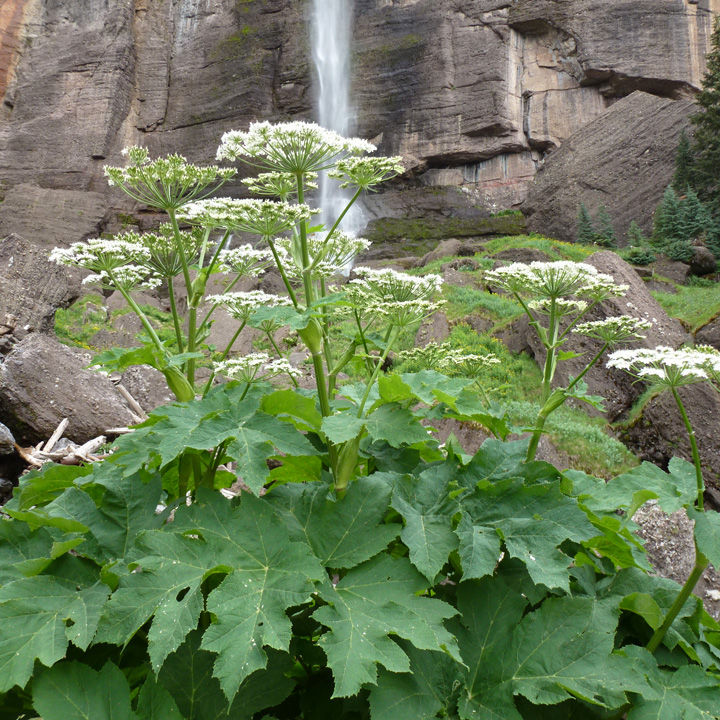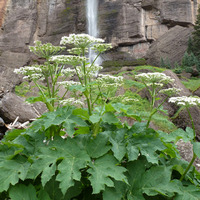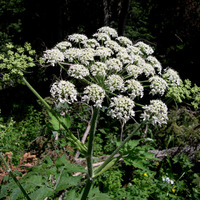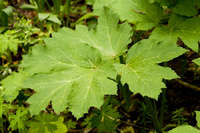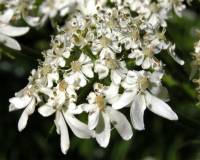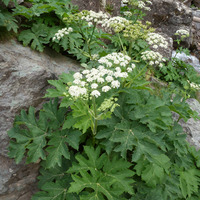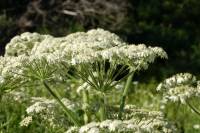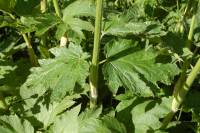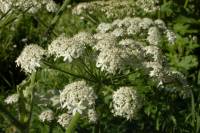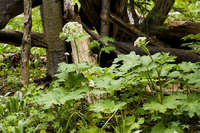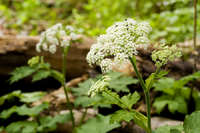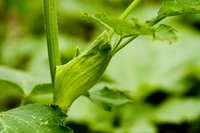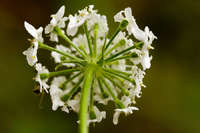An infrequent or rare plant in moist, rich soil along streams, about lakes, and along roadsides.
General: Perennial, 100-300 cm tall; stems solitary, glabrous to tomentose, especially at the nodes; taproot or cluster of fibrous roots.
Leaves: Alternate, compound, ovate to orbicular in outline, 20-50 cm long and nearly as wide, once ternate, with leaflets ovate to orbicular, usually with 3 main lobes that are lobed again, woolly-villous at least below, margins of the ultimate lobes serrate; petioles 10-40 cm long or absent on upper leaves, bases dilated, sheathing.
Flowers: Inflorescence of 1 to several compound umbels arising from decumbent or ascending scapes 4-20 cm long, with 5- 22 unequal rays, 0.2-9.5 cm long; phyllaries absent; pedicels 1-10 mm long, subtended by 4-8 bractlets, 2-5 mm long, the base distinct or united, apex acute to acuminate, margins entire; calyx teeth up to 0.5 mm long; petals purple or yellow; carpophore cleft to the base; flowers April-June.
Fruits: Schizocarp, obovate to obcordate, 8-12 mm long, 5-9 mm wide, dorsally flattened, wings on lateral ribs 1-1.5 mm wide, dorsal ribs narrow and wingless.
Ecology: Streambanks, wet meadows, disturbed areas, roadways; 1400-3000 m (4500-10000 ft); Apache, Coconino, and Navajo counties in Arizona; widespread throughout the U.S.
Notes: Cowparsnip can be direct-seeded into restoration treatments at relatively high elevations. It is widely used by northern tribes for a plethora of medical conditions, and many parts of the plant are eaten. Only the Paiute use it in our region, as a poultice of mashed root for rheumatism. The roots are also used to make a salve for sores and wounds, and a decoction of the roots is taken for colds.
Editor: Springer et al. 2008
Robust, single-stemmed perennial 1-3 m, generally ±pubescent or even tomentose; lvs once ternate, with broad, petiolulate, coarsely toothed and palmately lobed lfls mostly 1-3(-4) dm long and wide, the lateral ones mostly narrower than the central and often asymmetrical; terminal umbel commonly 1-2 dm wide at anthesis, with mostly 15-30 rays; bracts 5-10, narrow, deciduous; fr on pedicels 8-20 mm, obovate to obcordate, 7-12 mm, often pubescent; 2n=22. Rich damp soil; Lab. to Alas. and Siberia, s. to Ga. and Ariz. June, July. (H. sphondylium ssp. montanum, as to Amer. plants; H. maximum)
Gleason, Henry A. & Cronquist, Arthur J. 1991. Manual of vascular plants of northeastern United States and adjacent Canada. lxxv + 910 pp.
©The New York Botanical Garden. All rights reserved. Used by permission.


